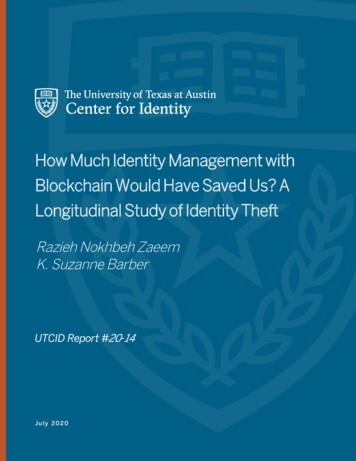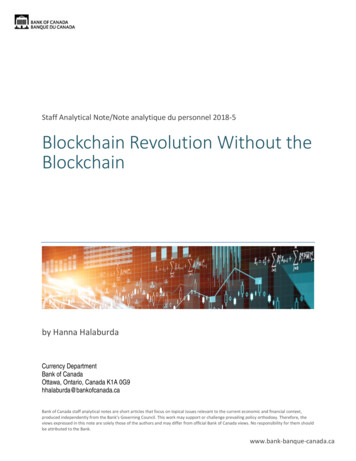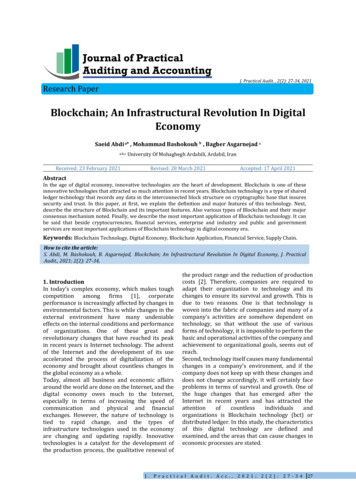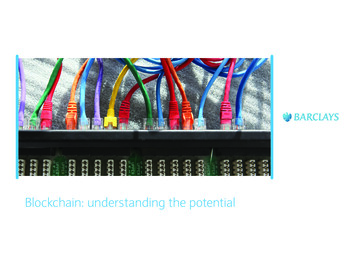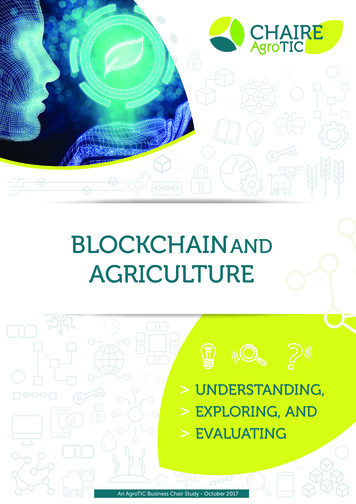
Transcription
LucidiTEE: A TEE-Blockchain System for Policy-CompliantMultiparty Computation with FairnessRohit SinhaSivanarayana GaddamRanjit KumaresanVisa sa Researchrakumare@visa.comABSTRACTMotivated by recent advances in exploring the power of hybridizedTEE-blockchain systems, we present LucidiTEE, a unified framework for confidential, policy-compliant computing that guaranteesfair output delivery. For context: Kaptchuk et al. (NDSS’19) showed that enclave-ledger interactions can enable applications such as one-time programs andrate limited logging. We generalize their ideas to enforcing arbitrary history-based policies within and across several multi-stepcomputations. Towards this, we define a new ideal functionality for policy-compliant computing FPCC , and then show howLucidiTEE implements FPCC . Chaudhuri et al. (CCS’17) showed that enclave-ledger interactionsenable fair exchange, contract signing, and more generally, fairsecure multiparty computation. In a setting with n processorseach of which possesses a TEE, they show how to realize fairsecure computation tolerating up to t corrupt parties for anyt n. We improve upon their result by showing a novel protocolwhich requires only t out of the n processors to possess a TEE.When n 2 and t 1, this provides practical fair computation inclient-server settings, where clients may not possess a TEE. Ekiden (EuroS&P’19) and FastKitten (Sec’19) use enclave-ledgerinteractions to enable practical, privacy-preserving smart contracts. However, Ekiden and FastKitten store the contract’s inputs on-chain (during malicious behavior in the latter’s case).In contrast, LucidiTEE implements privacy-preserving statefulcomputation while storing inputs, outputs, and state off-chain,using the ledger only to enforce history-based policies.Summarizing, LucidiTEE enables multiple parties to jointly computeon private data, while enforcing history-based policies even wheninput providers are offline, and fairness to all output recipients, in amalicious setting. LucidiTEE uses the ledger only to enforce policies;i.e., it does not store inputs, outputs, or state on the ledger, letting itscale to big data computation. We show novel applications includinga personal finance app, collaborative machine learning, and policybased surveys amongst an apriori-unknown set of participants.1INTRODUCTIONAlice wishes to analyze her monthly spending behavior using apersonal finance application, such as Mint [1]. Moreover, she seeksto gauge, and even control, how her transaction records are stored,analyzed, and further shared with other parties — however, mainstream applications today only present a privacy policy writtenin legalese, without any technical means to enforce them. We discuss Alice’s requirements from a new, transparent personal financeapplication that we build in this paper, called Acme.Ideally, Acme does not access her raw transaction data, and sheopts for only select functions from Acme (e.g. a monthly aggregatesummary), and control who can attain the output report. Moreover,she cannot provision her own servers (to engage in a multipartycomputation (MPC) protocol with Acme, for instance), and is expected to go offline at any time. For privacy and correctness, wemust enforce a policy over what inputs are supplied to a computation: 1) only a single instance of the analysis, over an entire month’sworth of transactions, is permitted, as opposed to multiple, finergrained analytics that can leak significantly more information abouther spending behavior (one-time program [2] policy); 2) all of hermonthly transactions are fed as input to the computation.As another example, Acme wishes to run a survey to collectfeedback from users (such as Alice), without having to build asurvey application but rather outsourcing it to a third-party service.Ideally, instead of trusting them to collect genuine responses, Acmewishes to enforce the following policy: 1) only accept inputs fromenrolled users of Acme; 2) all valid inputs are tallied in the output.These policies are expressed over inputs and outputs over theentire history of a computation, and across histories of multiplecomputations, and we call them history-based policies. It is anopen research problem to efficiently enforce such policies in a multiparty setting (such as the apps above), where the participants arenot known in advance, may not be online, and may act maliciously.In addition to enforcing policies, we wish to ensure fair outputdelivery to all participants, even when the computation is carriedout by malicious parties (e.g. when Acme computes on Alice’s data,or collaboration between businesses (see § 9.1). It is an open problemhow to provide fairness [3, 4] — if any party gets the output, then somust all honest parties — in a multi-party computation (malicioussetting), where a subset of the participants have commodity deviceswithout a trusted execution environment [4], such as end users.In this work, we build on recent advances in exploring the powerof a hybridized TEE-blockchain system (cf. [4–6] and referencestherein) to address the problem of policy-compliance on computations over user data. To that end, we provide a concrete definition for policy-compliant computation. Our definition takesthe form of an ideal functionality FPCC in the UC framework of [7].FPCC accepts user data and user-defined policies as inputs, andguarantees (1) confidentiality of inputs on which computations areperformed, and (2) fair output delivery to output recipients, and (3)execution of only policy-compliant computations.FPCC internally maintains a log of all function evaluations acrossall concurrent computations, and a computation-specific policycheck uses this log to determine whether to allow any furtherfunction evaluation. Additionally, the interfaces provided by ourFPCC abstraction are well-suited to the practical setting of repeated(big data) computations on user data which may grow over time,thereby expressive enough to enforce policies on this importantclass of applications. In more detail, parties provide their input datato FPCC once, and then bind it to an unbounded number of different
computations, and also use it for an unbounded number of stepswithin a computation without having to resupply it. This interfaceis valuable for Acme, whose input database contains information ofa large number of merchants and spans several GBs. FPCC allowsany (malicious) party to carry out the computation on behalf of thecomputation’s input providers (e.g. a cloud compute provider), butthe properties of policy compliance and fairness are ensured.Next, we present LucidiTEE, a hybrid TEE-blockchain systemthat exploits enclave-ledger interactions to provide a practicalimplementation of the abstractions provided by FPCC . We assume a method that computes on encrypted data — for instance,MPC protocols or TEE-based systems such as VC3 [8], Opaque [9],StealthDB [10], Ryoan [11], Felsen et al. [12], etc. — and insteaddescribe methods to enforce history-based policies and fair output delivery. While a variety of advanced cryptographic methodsexist to enable confidentiality of computations [13–15], enclavesprovide perhaps the most practical method for achieving this. Purecryptographic methods also fall short of guaranteeing fair outputdelivery [16], or enforcing policies across computations involvingdifferent sets of parties. Also, secure computation does not apply tosettings where participants are not known in advance or are offlineor where confidentiality is required when different sets of userscontribute input to different stages of a single computation [17, 18].only then proceed with the execution of the computation step. Inthe following sections, we demonstrate several interesting practical applications which exploit the power of history-based policies.We note that such an extension is not straightforward from the“Enclave-Ledger Interaction” scheme suggested by [5]—among otherthings, concretely, their ExecuteEnclave function takes only a single ledger post, whereas our policies may involve multiple entrieson the blockchain. Furthermore, unlike [5], our abstraction FPCC ,and consequently LucidiTEE, can enforce policies across severalcomputations. As an example, consider a survey application whereone might wish to enforce a policy that only those users who haveparticipated in a prior survey may participate in the current one.Next, we discuss our contributions to the design of practical fairexchange and fair computation protocols. By fairness, we meanthat either all output recipients obtain the output of a computationor none do. It is a well-known result [16] that fairness is impossibleto achieve in a setting where a majority of the participants arecorrupt. Faced with this result, several works have explored relaxednotions of fairness over the last few years [21–23]. However, veryrecently, Choudhuri et al. [4] showed that enclave-ledger interactions can enable fair secure computation. (Note that it is not knownwhether enclaves alone can enable the standard notion of fairnessin secure computation [24].) In a setting with n processors each ofwhich possesses a TEE, [4] show how to realize fair computationtolerating up to t corrupt parties for any t n. We improve upontheir result with a novel protocol which requires only t out of then processors to possess a TEE. When n 2 and t 1, this providespractical fair computation in client-server settings, where clientsmay not possess TEEs. This contribution is of independent interest.Improvements upon Related Work. While enclaves addressmany of the problems above, they still suffer from other problemssuch as rollback protection in a multiparty computation. Prior workhas employed blockchains for addressing state continuity, and alsoto support more robust designs involving a distributed networkof TEE nodes [6, 19]. Our work continues in the same vein. However, in addition to rollback protection, we rely on enclave-ledgerinteractions to (1) enforce policy compliance, and (2) guarantee fairoutput delivery. In the following, we first discuss how we extendideas from Kaptchuk et al. [5] (see also [20]) to use enclave-ledgerinteractions to enforce policies in computations. After that, wediscuss how we improve upon the work of Choudhuri et al. [4]to derive more practical protocols for fair output delivery and fairexchange. The latter may be of independent interest.Kaptchuk et al. [5] showed that enclave-ledger interactions canenable applications such as one-time programs and “rate limitedmandatory logging.” To support applications such as one-time programs, [5]’s strategy is to record (the first) execution of the programon the blockchain. Then, the enclave running the program wouldfirst check the blockchain to see if the program was executed already (in which case it would abort), and if no record of programexecution exists on the blockchain, then continue execution of theprogram. In the problem of rate limited mandatory logging, thegoal is to log access to sensitive files before the necessary keysfor an encrypted file can be accessed by the user. Here again, [5]’sstrategy is to first check the blockchain to log the file access, andonly then let the enclave release the key. See [5] for more details.Extending [5], we provide general techniques to enforce arbitrary history-based policies within and across several multistagecomputations. At a high level, we implement such history-basedpolicies by allowing the enclave executing a step of a computationto scan through the ledger to identify policies associated with thecomputation, and first check if the inputs to the computation stepcomply with the policies associated with the computation, andSystem Design. LucidiTEE provides a practical and scalableframework for privacy-preserving, policy-compliant computations.In our example applications, the inputs span large databases (suchas Acme’s proprietary database in § 9.1.1). The inputs also arrivefrom a large number of apriori-unknown users, such as in publicsurveys (§ 9.1.2) and applications that provide a service based onaggregate data of its growing consumer base (e.g., § 9.1.3). Finally,the set of computations grow over time as parties enroll in newcomputations that consume results from prior computations.LucidiTEE supports history-based policies with the use of ashared ledger or blockchain, which plays the role of the log inFPCC — since rollback or tampering attacks on the log can violatepolicy compliance and fairness, we use a shared ledger (accessibleby all parties) in lieu of a centralized database. LucidiTEE achievesscalability by minimizing use of the ledger. To support the abovementioned applications, we record only commitments (i.e., hashdigests, which support membership queries) of the inputs, outputs,and the updated state on the ledger after each function evaluation.We note that the recent works of Ekiden [6] and FastKitten [25] alsouse enclave-ledger interactions to enable privacy-preserving smartcontracts. However, Ekiden and FastKitten store the contract’s inputs on-chain (during malicious behavior in the latter’s case). Incontrast, LucidiTEE stores inputs, outputs, and state off-chain (recall only commitments to these go on-chain), using the blockchainonly to enforce history-based policies. Furthermore, we use remoteattestation [24, 26] to allow any party to act as a compute providerby providing a genuine TEE-enabled processor. For these reasons,we say that LucidiTEE embodies “bring-your-own-storage" and2
MerchantID52544965Alice’sTransactionData Amount2014-06-0313:37 PM 23.00 2014-06-2920:49 PM 48.12Aliceand BankB. Alice’s data is either imported manually by her, ormore conveniently, provided by Alice’s bank, via an OAuth-basedOFX API [27] that pushes transaction data one-by-one as they aregenerated by her. Today, an application like Acme often hosts theusers’ raw data, and is trusted by them to adhere to a legalese policy.Bank rchantIDCategory52544965Restaurants 12144989Gas StationsThe application may be hosted by a malicious compute provider,who may collude with any party to violate either Alice’s or Acme’sprivacy. Therefore, we discuss some concrete requirements of thesystem to ensure guarantees of policy compliance and fairness.ReportPrivacy through TransparencyAcmeBank BWe find that transparency and control — i.e., enforcing which functions can be evaluated, and with whom the outputs are shared —are necessary for enforcing any measure of privacy. Without thisbasic enforcement, an attacker can proliferate arbitrary functionsof sensitive user data. In our example, Alice wishes that the approved output recipients only learn the output of function f (onone months’ worth of transaction data), and nothing else about hertransaction data, such as her spending profile at daily granularityor the location patterns. For this reason, f cannot be evaluated bysharing Alice’s plaintext data with Acme, or vice versa as Acmealso wishes to maintain secrecy of its proprietary database.Figure 1: Transparent Personal Finance Application“bring-your-own-compute" paradigms , lending flexibility to theuntrusted compute providers to manage their storage and compute.In summary, we make the following contributions: definition of an ideal functionality FPCC for multi-party, concurrent, stateful computations, with enforcement of history-basedpolicies for offline parties and fairness for all output recipients LucidiTEE, a system that realizes this ideal functionality, usingTEEs and a shared ledger protocol for fair n-party output delivery, requiring a shared ledgerand t parties to allocate a TEE, for any corruption threshold t n.We also provide a formal proof of security in the UC framework. evaluation of several applications, including a personal financeapplication (serving millions of users), federated machine learning over crowdsourced data, and a private survey. We also implement one-time programs, digital lockboxes, and fair exchange.2Strawman ApproachBoth parties first encrypt their data before uploading itto a compute provider (such as Acme or a cloud service).Next, to allow the agreed-upon evaluation of function fon their data, both parties establish a TLS channel (basedon remote attestation) with an enclave program (loadedwith function f ) running on an untrusted host softwareat the compute provider, and share the decryption keys tothe enclave. Then, the enclave evaluates f , encrypts theoutput under the output recipients’ public keys, and asksthe compute provider to transmit the encrypted output.OVERVIEW OF LUCIDITEEIn this section, we introduce the components of our system using anexample personal finance application. The design principles behindour system should be evident even when considering applicationsfrom different domains such as joint machine learning, etc.2.1Requirements of AcmeAs a first step towards transparency and control, this designensures that only f is computed on inputs from Alice and Acme,and that no other party beyond Alice, BankA, and BankB can observe the output. Note that the input providers can go offline afterproviding their inputs, and the output recipients come online onlyto retrieve the outputs. There are several TEE-based systems thatfit this general design, such as VC3 [8], Opaque [9], StealthDB [10],Ryoan [11], Felsen et al. [12], etc., which we can use to implementthe function f . To restrict scope, f is assumed to be safe (e.g., without additional leaks via side channels), so we execute f as given.Motivating Example: Personal Finance AppThe open banking initiative [27] has fostered a variety of personalfinancial applications. Figure 1 illustrates a sample financial application by Acme, who provides a service for viewing aggregatespending behavior (i.e., the proportion of spending across categoriesfor all transactions in a month), along with the feature to share thisaggregate report with third parties (such as lending institutionswho can provide mortgage offers).To perform this joint computation, Acme maintains a proprietarydatabase mapping merchant ids to category labels; Alice’s dataconsists of a set of transaction records sorted by time, where eachrecord contains several sensitive fields such as the merchant id,the amount spent, and the timestamp. The aggregation function(denoted by f ) is evaluated over inputs from Alice and Acme, andthe output is shared with Alice and two lending institutions, BankAHistory-based PoliciesWhile this strawman ensures that only f can be evaluated on Alice’sinput, we illustrate how this is insufficient for Alice’s privacy.Recall that Alice’s bank (we can treat Alice and her bank asone logical party) uploads encrypted transaction records to thecompute provider (using the OFX API [27]), one-by-one as they aregenerated by Alice. The enclave’s host software is controlled byan untrusted compute provider, who may perform attacks such as3
rewinding the persistent storage and launching multiple instancesof the enclave program. Hence, an adversarial compute providermay repeat the computation with progressively smaller subsets ofAlice’s (encrypted) transaction data from that month (and colludeto send the output to a corrupt party) — note that each of thesecomputations is independently legal since it evaluates f on aninput containing Alice’s transactions that are timestamped to thesame calendar month. By comparing any pair of output reports,the attacker infers more information about the transactions thanwhat is leaked by the monthly aggregate report; for instance, onemay learn that Alice tends to spend frivolously towards the endof the month1 . In general, this form of a rewind-and-fork attack isdetrimental for applications that maintain a privacy budget [28].To counter such attacks, we enforce history-based policies, wherethe decision to execute the next step in a computation depends onthat computation’s history (and the history of any other computations over the input data) which contains some metadata aboutthe inputs and outputs of a computation. In Acme’s example, Aliceuses the following history-based policy ϕ : all transactions must 1)be fresh, in that they have never been used by a prior evaluation off , and 2) belong to the same month.History-based policies find use in applications that maintainstate, have privacy budgets, or make decisions based on prior inputs.We urge the reader to look at history-based policies in § 9.1, such asprivate surveys amongst unknown participants with policies acrosscomputations (e.g. survey only open to users who participated ina previous survey, or only open to Acme users) — smart contractson Ekiden [6] or FastKitten [25] cannot read the ledger entries (ofother contracts), and therefore cannot implement such applications.To our knowledge, this is the first work to study such policiesin a multi-party setting (where participants may be offline or actmaliciously), and enforcing them incurs the following challenges.For instance, multiple parties may compute concurrently, and attempt to append the computation’s history on the shared ledger —there must be some conflict resolution to enable concurrency acrosscomputations, but also ensure policy compliance. Furthermore, wemust develop efficient methods to check policies such as k-timeprograms and accounting of all inputs.require Alice to possess a device with a TEE — the enclave-ledgerprotocol in [4] requires all parties to possess a TEE.2.3 Acme on LucidiTEESpecifying and Creating ComputationsA computation’s semantics is specified by a string, which anyonecan post to the ledger for inspection by all parties. In Acme’s case:computation { id: 42, /* unique id */inp: [("txs": pk Alice), ("db": pk Acme)],out: [("rprt": [pk Alice, pk BnkA, pk BnkB])],policy: 0xcoff.eeee, /* r txs. consumed(r) */func: 0x1337.c0de /* aggregate function */ }Each computation on LucidiTEE has a unique id. The in field lists aset of named inputs, along with the public key of the input provider(who is expected to sign those inputs). Similarly, the out field listsa set of named outputs, where each output has one or more recipients. The evaluation function f and the policy function ϕ areimplemented as enclave programs, for confidentiality and integrity,and we uniquely identify them using the hash of the enclave binary.A computation progresses via a potentially unbounded sequenceof stateful evaluations of f , guarded by ϕ, and it is said to be compliant if all constituent steps use the function f and satisfy ϕ. Unlikef , ϕ takes the entire ledger as input. In our example, ϕ encodesthe freshness property that no transaction within txs has beenconsumed by a prior evaluation of f ; we can implement ϕ by performing membership test for each transaction (in txs) within theinputs consumed by prior evaluations of f in computation of id 42,or more efficiently, by maintaining state containing an accumulator(e.g. a Merkle tree) of all transactions previously consumed by f .Enforcing Policies and Performing ComputationHistory-based Policies via Shared LedgersWe introduce an append-only ledger, which is shared atleast between Alice and Acme, but more generally, a globalset of users to enforce policies across multiple applicationsthat process some data. The ledger fulfills a dual purpose.First, a protocol (see § 7) forces the compute provider torecord the enclave’s evaluation of f on the ledger beforeextracting the output — for each function evaluation, werecord a hash-based commitment of the encrypted inputs,outputs, and intermediate state. Second, enclave programsread the ledger to evaluate the policy ϕ.FairnessA policy also enforces the set of output recipients: Alice, BankA,and BankB. Simply encrypting the output under their public keysensures that other parties cannot observe the results of the computation (assuming confidentiality of enclave execution). However,a malicious compute provider can collude with a subset of output recipients, and deliver the encrypted outputs to only thoseparties — since all network communication is proxied via the compute provider, an enclave cannot ensure that an outbound messageis sent, and therefore, must assume lossy links, making reliablemessage delivery impossible [29].Without having to trust Acme, Alice wishes to have her monthlyreports sent to a set of chosen banks, perhaps to get lucrative loanoffers. For Acme to be transparent, we argue that it must also ensurefairness: if any party gets the output, then so must all honest parties.Moreover, a protocol for fair output delivery should ideally notThe compute provider allocates a TEE machine, and downloadsAlice’s and Acme’s encrypted inputs onto the machine’s local storage — this expense may be amortized across several function evaluations. Next, Acme must convince an enclave that the requestedfunction on Alice’s inputs is compliant. To that end, Acme launchesan enclave implementing the policy predicate ϕ, and provides itwith a view of the ledger. Note that a malicious compute providercan provide a stale view of the ledger (by simply ignoring recentledger entries), and our protocol defends against such attacks byrequiring a proof that no relevant computation occurred since theledger height at which ϕ is evaluated. On approval from ϕ, Acmelaunches an enclave to evaluate f , which gets the encrypted inputs’1 Whilemetadata, such as authenticated batches of inputs, can remedy this attack,banks may be unwilling to generate this data for each third-party app.4
Due to compute chaining, c also specifies the computations fromc ), and computations whichwhich it receives inputs (denoted C inc ). Since input providers may goconsume its outputs (denoted C outoffline after binding their input to a computation c, they are notrequired to authorize each step of c — an input may be used foran unbounded number of steps of c (for instance, Acme’s inputis used to service multiple users for multiple months), as long asc.ϕ approves each step and c has not been revoked. Moreover, aninput may be bound to several computations concurrently, avoidingunnecessary duplication of the data. FPCC is defined as follows:decryption keys from a key manager (also implemented as an enclave; see § 7), and produces an output encrypted under the publickeys of all output recipients. In § 7, we discuss practical methodsto enforce several classes of policies.LucidiTEE is oblivious to how or where the encrypted data isstored, and the ledger size is independent of the size of the inputs.Therefore, we stress that LucidiTEE uses the ledger only to enforcepolicies, and embodies a “bring-your-own-storage" paradigm. Moreover, since LucidiTEE uses trusted enclaves and an append-onlyledger to enforce the policy, any (malicious) compute provider canbring TEE nodes and evaluate ϕ and f . Hence, we emphasize thatLucidiTEE also embodies a “bring-your-own-compute" paradigm.Fair Reconstruction of OutputsSince fairness is impossible to achieve in a setting where a majorityof the participants are corrupt [16], several works have exploredrelaxed notions of fairness over the last few years [4, 21–23] —specifically, Choudhuri et al. [4] showed that enclave-ledger interactions can enable fair secure computation. Our work continues inthe same vein, and improves upon their result.Inspired by [30, 31], we reduce fair computation to fair reconstruction of an additive secret sharing scheme, as follows. The enclave’s evaluation of f encrypts the output under a fresh, randomkey k. The enclave also emits shares of k for all output recipients:Enc(pk Alice, k1 ), Enc(pk BankA, k2 ), and Enc(pk BankB, k3 ), s.t.k k1 k2 k3 , for random k1 , k2 , and k3 . All output recipients mustengage in the reconstruction protocol with their key shares. Forbest case security (static corruption model), we set the corruptionthreshold t in Acme’s example to 2, thus withstanding byzantinebehavior from any 2 of the 3 parties. The protocol requires t 2parties to provide a TEE node (e.g., BankA and BankB). Protocol for Fair N-Party ReconstructionThe protocol withstands an arbitrary corruption thresholdt n, and it requires any t recipients to allocate a TEEmachine, and all n parties to access the shared ledger — incontrast, [4] needs all n parties to allocate a TEE machineand access the ledger, which is cumbersome for end users. 3IDEAL FUNCTIONALITY OF LUCIDITEEWe define an ideal functionality that performs concurrent, statefulcomputations amongst arbitrary sets of parties. The universe ofparties is an unbounded set, denoted by P , of which any subset ofparties may engage in a computation. Each computation c involvesc and a set of output recipients P c , whicha set of input providers P inoutc P c ) P . We assume a polynomialmay overlap, such that (Pinouttime static adversary A that corrupts any subset P A P , who actmaliciously and deviate arbitrarily from the protocol. The attackerselects the inputs and learns the output of each party in P A .We introduce an ideal functionality for policy-compliant computing, FPCC . Each step of a computation evaluates a transitionfunction f if allowed by the policy predicate ϕ (expressed over theinputs and a ledger of all prior function evaluations). Each computation is defined by a specification c, which fixes f , ϕ, and thec and the output recipients P c .identities of the input providers P inoutPolicy-compliant Computing: FPCCThe functionality has a private storage db and a publicly readablelog ldgr, which are empty at initialization. db is indexed by handles, and supports an add(x ) interface (which returns a uniquehandle h from the set {0, 1}poly(λ) ) and a update(h,x ) interface.c , output recipiOn parsing c, we get the set of input recipients P inc , and the set of chained computations C c and C c . Theents P outoutinret statement returns a value to a party and terminates executionof the
p a a. pcc in. pcc pcc) ) .

